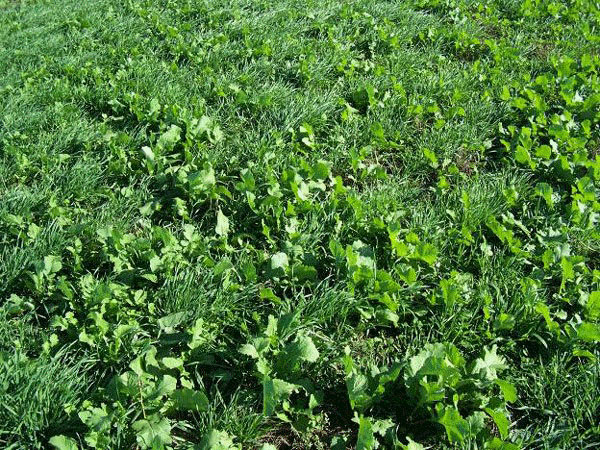Enhanced forage allowance in late fall and early winter improves the forage budget in forage-based livestock systems. Spring oats and turnips can be an alternative, especially when farmers want to extend the grazing period.
Most producers plant spring oats in spring. However, spring oats can also be planted in late summer for fall and early winter grazing. Spring oats will die out after the first hard freeze in the mid 20’s. Oats are a high-quality forage, almost as good as wheat. Since oats do not have awns, cattle can graze them easily.
Is it possible to plant oats and turnips at the same time? The answer is yes. Some wildlife hunters plant oats and turnips for their deer food plots in the fall. Producers can use the same concept for beef grazing in the fall.
Forage turnip is one of the forage brassicas (forage rape, turnip, kale, and swedes) and has very high nutritive value with 24 - 25% crude protein in leaves and 16-18% crude protein in the bulbs. Forage turnip has a high moisture content, so it’s unsuitable for hay. The high moisture content of forage turnips can also be too “washy” for livestock, so it is recommended that animals have free choice of dry hay or dry forage along with the turnips.
Oats and turnips can be planted simultaneously using a grain drill with a second, small seed box for turnip seeds. If a small seed box isn’t available, the turnips can be broadcast ahead of oat drilling. The soil disturbance from the drill is generally enough to get the turnip started after a rain. When including a brassica, seeding depth is more limited due to the small seed size. A depth of ½ inch is ideal. If drilling with two boxes, you can dribble the turnips on top of the ground and then drill the oats to a depth of 0.75-1.50 inches. The seeding rate for oats is 50 to 75 pounds per acre, depending on how early it’s planted and moisture availability. For example, in eastern Kansas and under irrigation, seeding rates would be at the higher end of this range or even higher. Seeding rates would also be higher when planting dates are later, although at later planting dates, there will be less forage and higher seed costs. For turnip, the seeding rate is 2 pounds per acre.
Turnip is more winter hardy than oats and can continue to grow into winter while maintaining its greenness even under snow cover. To have more growth, about 50 lbs of nitrogen per acre can be applied at planting. If the oats and turnips are planted after a failed corn or sorghum crop, they may not need this much of applied nitrogen. Both oats and turnips can accumulate high nitrates, so be careful. Forage should be tested before grazing. Samples can be submitted for analysis through the local county Extension office.
The potential yield for an oats and turnip mixture might be 2 to 3 tons of dry matter per acre. Depending on the soil moisture, producers can start grazing about 6 to 8 weeks after the oats and turnips are planted.

Figure 1. Spring oats and turnip pasture. Photo by D. Shoup, K-State Research and Extension.
Doo-Hong Min, Forage Agronomist
dmin@ksu.edu
Romulo Lollato, Wheat and Forages Specialist
lollato@ksu.edu
Tina Sullivan, Northeast Area Agronomist
tsullivan@ksu.edu
Tags: grazing fall forage spring oats turnips